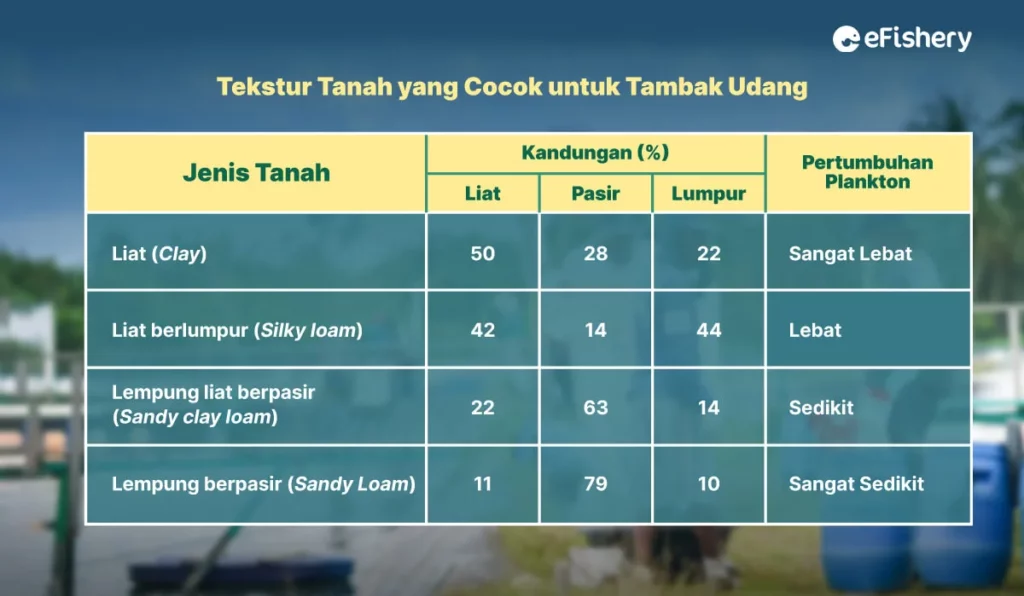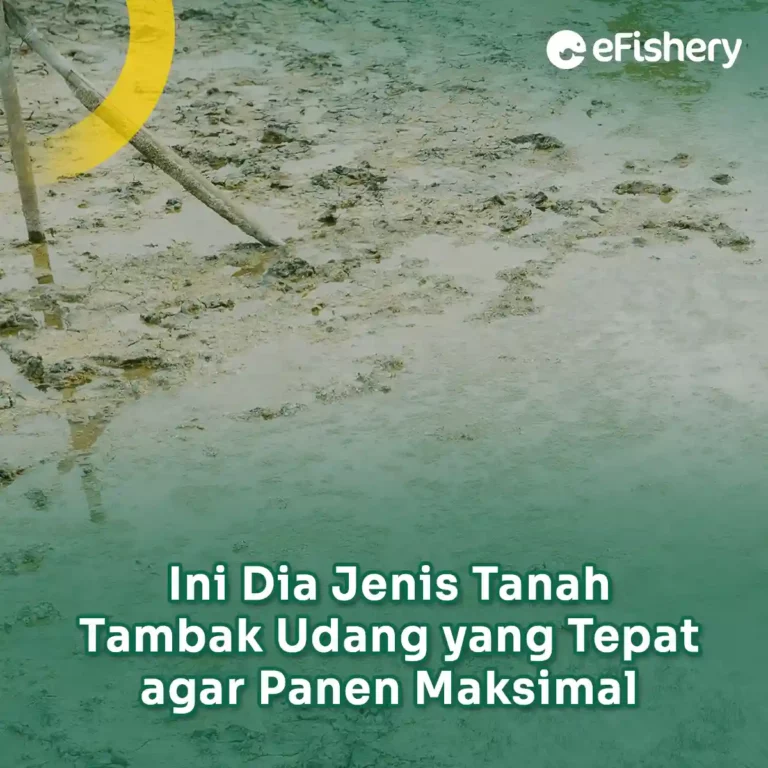Artikel Ini Telah Direview Oleh:

Nabilla Anggi
Magister Budidaya Perairan
Choosing pond soil for shrimp farming is an important factor that must be considered before starting a farming business. Good soil for use as a pond is soil that is able to hold water or does not leak, and contains organic matter such as Phosphorus (P), Nitrogen (N), and Carbon (C).
The texture of pond soil that is suitable for shrimp farming will be discussed in full in this article. Check out the explanation!
Good Nutrients for Ponds
Nutrients in pond soil will affect the continuity of cultivation. Here are some of the nutrients needed for shrimp farming:
1. Phosphorus (P)
The function of phosphorus is to encourage the growth of phytoplankton which serves as a natural food for shrimp, while maintaining the stability of water quality. If the phosphorus content in the pond soil is still low, farmers can apply fertilization during preparation for cultivation.
2. Nitrogen (N)
Nitrogen in the pond soil is useful for neutralizing ammonia into organic matter that can be utilized by phytoplankton.
3. Carbon (C)
Carbon functions to produce an energy source for bacteria so that it can break down organic nitrogen. Carbon content greatly affects the quality of shrimp pond water, especially pH and dissolved oxygen.
Organic matter content in ponds can come from leftover feed, metabolic waste, fertilizers, dead plankton, and several other sources. Organic materials do not directly affect aquaculture organisms, but can affect water quality and plankton in ponds.
Soil Texture Suitable for Shrimp Ponds
Soil selection is very important in preparation for cultivation. Before determining the cultivation system to be used, you must know the type of soil with a texture that is suitable for making ponds. You can choose soil that contains sufficient nutrients and has a texture suitable for ponds.
The following is a soil texture that is suitable for ponds:

Pond fertility is generally determined by the clay content in the soil which can reach levels of 50%. Sandy loam soil types are very suitable for natural food growth, while sand and silty sand soil types are very porous, so they cannot hold water and have minimal nutrients.
Manage Pond Land with Cultivation Consultation at eFarm!
Need Help Regarding Shrimp Cultivation Business?
Fill in your personal data in the following form. Our team will immediately contact you via the number cellphone attached. Make sure the data entered is correct.
As a farmer, surely you need guidance before starting shrimp farming. Mr / Ms can usefeature Cultivation Consultation from eFarm. Feature Cultivation Consultation provides free consulting services with aquaculture experts so that you can get the right cultivation steps to get optimal harvests.
Interested in doing a free consultation for your shrimp farming? Don't think about it anymore, have the app right away eFarm for free and try features Cultivation Consultation!

Nabilla Anggi - Magister Budidaya Perairan
Nabilla merupakan lulusan sarjana dan magister budidaya perairan serta memiliki pengalaman di dunia perikanan baik hatchery maupun pembesaran
Questions Regarding Shrimp Pond Land
The types of soil suitable for ponds are clay, muddy loam, sandy loam, and sandy loam. Sandy loam soil types are very suitable for natural food growth, while sand and silty sand soil types are very porous, so they cannot hold water and have minimal nutrients.
Shrimp suitable for cultivation in areas with pond soils that have adequate availability of nutrients such as Phosphorus (P), Nitrogen (N), and Carbon (C). These nutrients are very useful in support shrimp growth.
- Afrianto, E and E. Liviawaty. 1991. Shrimp Pond Manufacturing Technique. Canisius. Yogyakarta.
- Avnimelech Y and Rivto G. 2003. Shrimp and Fish Pond Soil: Process and Management. Aquaculture. Vol. 220 (1-4):549-567.
- Barg U C. 1992. Guidelines for the promotion of environmental management of coastal aquaculture development. Rome, Italy: Food Agriculture Organization of the United Nations
- Boyd, C.E. 2003. Organic Matter In pond bottom sediment. Global Aquaculture Advocate.
- Hidayanto, M, Agus HW., and Yossita F. 2004. Pond Soil Analysis as an Indicator of Pond Fertility Level. Journal of Agricultural Technology Assessment and Development. 7(2): 180-184.
- Jasmin, S, Ramlan, Monda A. 2017. Identification of Soil Characteristics of Converting Forest Land Functions to Cocoa (Theobroma cacao L) Plantations in Parigimpuu Village, West Parigi District, Parigi Moutong Regency. Agroland Journal. Vol. 24(3):214-221.
- Suprapto N, Chang T and Ku C. 2017. Conception of learning physics and self-efficacy among Indonesian university students. Journal of Baltic Science Education. Vol. 16(1): 7-19.
- Tamanampo J. 2004. Aquatic Ecology (Freshwater Ecology). Faculty of Fisheries, University of Sam Ratulangi). Manado.
